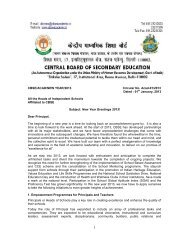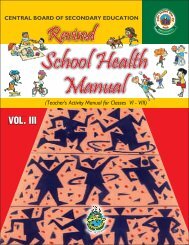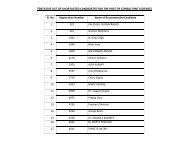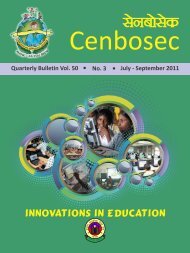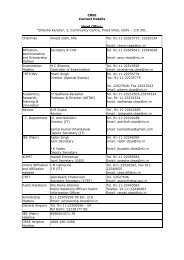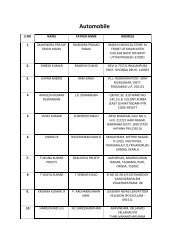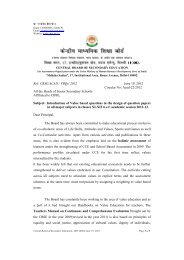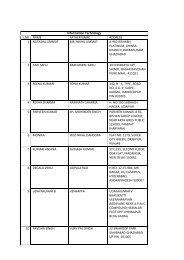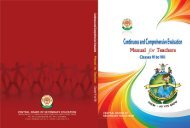to view or download - CBSE
to view or download - CBSE
to view or download - CBSE
- No tags were found...
Create successful ePaper yourself
Turn your PDF publications into a flip-book with our unique Google optimized e-Paper software.
BASIC EMERGENCY CAREAppendix-VCardiac arrest occurs in 70% of individuals at home and 20% at w<strong>or</strong>kspace and only in 10% at hospital.It is therf<strong>or</strong>e imp<strong>or</strong>tant that non-healthcare persons such as schoolchildren, teachers, police anddrivers should learn how <strong>to</strong> o save life and transp<strong>or</strong>t the patient <strong>to</strong> the nearest health facilit.Cardiopulmonary resucitation (CPR) is a procedure <strong>to</strong> supp<strong>or</strong>t and maintain breathing and cirulationf<strong>or</strong> a person who has s<strong>to</strong>pped breathing (respira<strong>to</strong>ry arrest) and/<strong>or</strong> whose heart has s<strong>to</strong>pped (cardiacarrest.)Basic Emergency Care (BEC) is the emergency care which can be provided by schoolchildren,teachers, police and drivers in the absence of advanced medical care. If one school kid is trained inCPR, he <strong>or</strong> she can take care of his peers, family members and community at large.Beside CPR and f<strong>or</strong>eign body reomoval, it also includes considerations of patient transp<strong>or</strong>t suchas the protection of the cervical spine and avoiding additional injuries through splinting andimmobilization.When witnessing sudden collapse in victims of all ages, the rescuer should first telephone the emergencymedical services system and then return <strong>to</strong> continue CPR (phone first). But f<strong>or</strong> unwitnessed arrest(eg drowning, drug overdose and injured), the rescuer should deliver five cycles of CPR bef<strong>or</strong>e callingemergency number and then continue CPR (phone fast).THE CHAIN OF SURVIVALThe highest survival rate from cardiac arrest can be achieved only when the following sequence ofevents occurs as rapidly as possible :1. Early recognition of warning signs2. Activation of emergency medical services3. Basic CPR4. Defibrillation5. Management of airway and ventilation6. Intravenous administration of medicationsFigure 1 : The adult chain of survival. The 4 links of actions in the chain are (1) phone (2) CPR, (3)early defibrillation and (4) advanced care91





